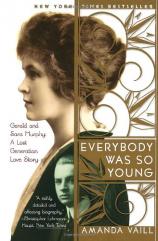Reading Group Guide
Discussion Questions
Everybody Was So Young: Gerald and Sara Murphy: A Lost Generation Love Story

1. Gerald and Sara Murphy were surrounded by artists and writers--from Cocteau to Dorothy Parker--who epitomized the modernist spirit of the 1920s. Was this accidental, or purposeful?
2. "The very rich are different from you and me," Scott Fitzgerald supposedly told Ernest Hemingway, to which Hemingway (who told this anecdote) replied, "Yes, they have more money." How well does each man's statement apply to the Murphys?
3. "Only the invented part of our lives--the unreal part--has had any scheme, any beauty," wrote Gerald to Scott Fitzgerald in 1935. What parts of their lives did they "invent," and what parts were "the unrealistic things?" Do you agree with Gerald?
4. "Paris is bound to make a man either more or less American," Gerald Murphy told a newspaper interviewer in 1923. How was this statement true of Murphy, and of Cole Porter, Hemingway, MacLeish, Fitzgerald, Dos Passos, and the other expatriate artists of the period? What was it about Paris that made it happen?
5. To the Murphys, their children were "the real foundation of our future happiness." How would you evaluate the Murphys' role as parents? Were they attentive and caring or narcissistic and irresponsible? In what ways did both Gerald and Sara act as surrogate parents for their own contemporaries?
6. The Murphys' marriage was severely tested by five decades, but it endured. Why? What were the pressures on it? And was their relationship truly "a love story"?
7. Sara Murphy had close relationships with at least three men besides her husband: Scott Fitzgerald, Ernest Hemingway, and Pablo Picasso. Do you believe that these relationships were sexual or platonic? On what do you base your opinion?
8. "I was never happy until I started painting," said Gerald Murphy in 1956, "and I have never been thoroughly so since I was obliged to give it up." Why was he "obliged" to give up something he loved so passionately and which he did so well? Or was his statement misleading? Also, what hidden references to events or people in his life can you find in his pictures?
9. In A Moveable Feast, his posthumous memoir of 1920s Paris, Ernest Hemingway paints a cruel picture of the Murphys as the unnamed "rich" who seduced him into superficiality and infidelity. Why would he describe them in this way?
10. Are the Murphys just a footnote, or did they contribute something substantial to twentieth-century cultural history?
11. The media have often compared the 1990s to the 1920s. Judging from the social circles described in Everybody Was So Young, do you find many similarities between these decades? Are there any contemporary couples who have the Murphys' role today?
12. Referring to Scott Fitzgerald's Tender Is the Night, Sara Murphy said, "I hated the book when I first read it. I reject categorically any resemblance to ourselves or anyone we know--at any time." What differences and similarities do you see between the Murphys and Dick and Nicole Driver? Discuss the perceptions of the Murphys portrayed in Fitzgerald's short story "Babylon Revisited," Ernest Hemingway's The Sun Also Rises and "Snows of Kilimanjaro," Archibald MacLeish's poem "Portrait of Mme G___M___" and his play J.B., and Pablo Picasso's "Woman in White."
Everybody Was So Young: Gerald and Sara Murphy: A Lost Generation Love Story
- Publication Date: April 20, 1999
- Paperback: 512 pages
- Publisher: Broadway
- ISBN-10: 0767903706
- ISBN-13: 9780767903707







